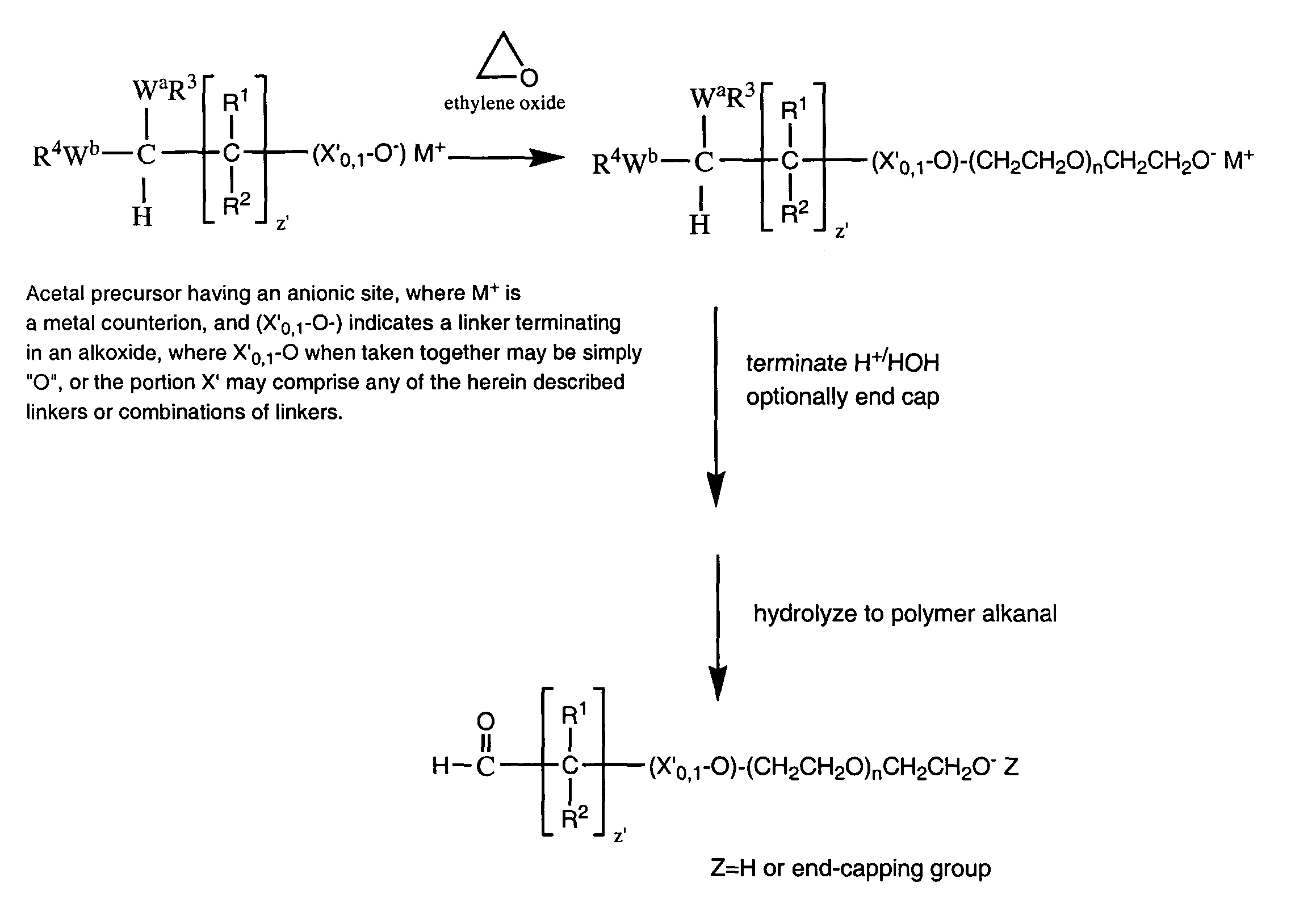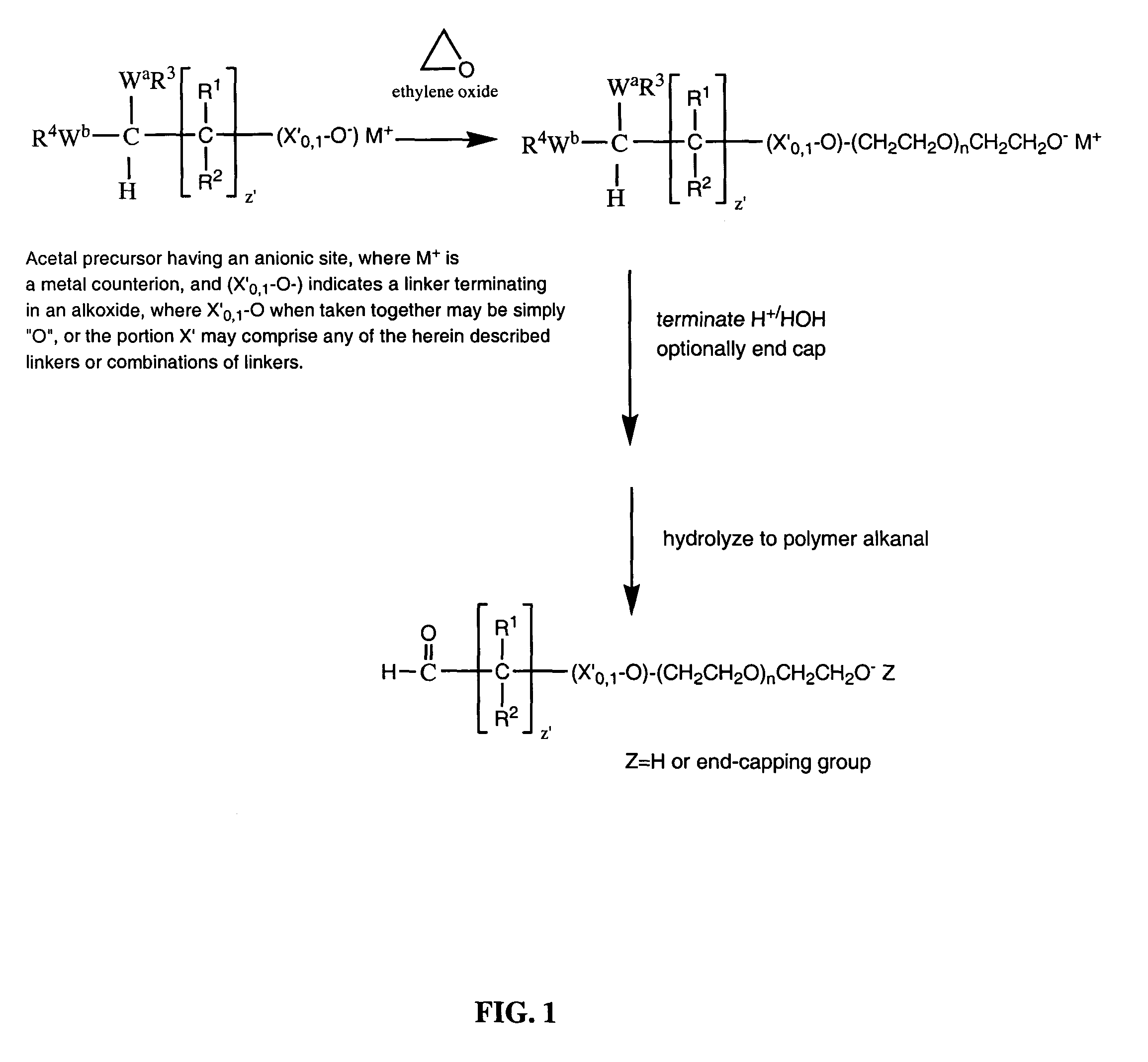Water-soluble polymer alkanals
a water-soluble polymer and alkanal technology, applied in the field of aldehyde derivatives of water-soluble polymers, can solve the problems of short circulating half life, lack of selectivity, immunogenicity, proteolytic degradation,
- Summary
- Abstract
- Description
- Claims
- Application Information
AI Technical Summary
Benefits of technology
Problems solved by technology
Method used
Image
Examples
example 1
Synthesis of mPEG (2K)-Butyraldehyde
[0301]
A. Preparation of mPEG (2K Da)-Butyraldehyde, Diethyl Acetal.
[0302]
[0303]A mixture of MPEG (2K Da) (2.0 g) and toluene (30 mL) was azeotropically dried by distilling off toluene under reduced pressure. The dried mPEG, molecular weight, 2 kilodaltons, was dissolved in anhydrous toluene (15 ml) to which was added a 1.0 M solution of potassium tert-butoxide in tert-butanol (4.0 ml, 0.004 moles) and 4-chlorobutyraldehyde diethyl acetal (0.5 g, 0.00277 moles) (Alfa Aesar). The mixture was stirred at 100–105° C. overnight under an argon atmosphere. After cooling to room temperature, the mixture was filtered and added to 150 ml ethyl ether at 0–5° C. The precipitated product was filtered off and dried under reduced pressure. Yield: 1.6 g. The reaction proceeded in essentially a quantitative yield. That is to say, essentially all of the mPEG starting material was converted to the corresponding diethyl acetal, based upon the absence of hydroxyl proto...
example 2
SYNTHESIS OF MPEG (30 kD)-BUTYRALDEHYDE
A. Preparation of mPEG (30K Da)-Butyraldehyde Diethyl Acetal,
mPEG30K-O—CH2(CH2)2—CH(OCH2CH3)2
[0309]A mixture of mPEG (30 kD) (60% solution in toluene, 3.30 g), toluene (30 ml) and BHT (butylated hydroxytoluene, 0.004 g) was azeotropically dried by distilling off the solvent under reduced pressure. The dried mPEG 30K was dissolved in anhydrous toluene (15 ml), and to this solution was added 1.0 M potassium tert-butoxide in tert-butanol (4.0 ml, 0.004 moles), 4-chlorobutyraldehyde diethyl acetal (0.5 g, 0.00277 moles) (Alfa Aesar), and potassium bromide (0.05 g). The resulting mixture was stirred overnight at 105° C. under argon atmosphere. The mixture was filtered, concentrated to dryness under reduced pressure and the crude product was dissolved in 20 ml of dichloromethane. This product-containing solution was added to ethyl ether (300 ml) at room temperature to precipitate the product. The precipitated product was isolated by filtration and d...
example 3
Comparative Stability of mPEG-Propionaldehyde and mPEG-Butyraldehyde at Basic pH
[0315]Methoxy-PEG-propionaldehyde and mPEG-butyraldehyde were each exposed to high pH conditions for prolonged periods of time to compare the relative stability of each polymer under basic pH conditions. As indicated below, significant amounts of propionaldehyde PEG reacted under these conditions to form mPEG-OH and release acrolein (due to a retro-Michael type reaction), while no loss of the PEG butyraldehyde compound was detected. The details of this experiment are provided below.
A. Stability of mPEG(2K Da)-Butyraldehyde at Basic pH
[0316]mPEG(2K Da)-butyraldehyde (from Example 1) (0.5 g) was dissolved in 10 ml 5 mM phosphate buffer (pH=8.0) and the resulting solution was stirred for 24 h at room temperature. NaCl (0.5 g) was added and the product was extracted with methylene chloride (3×10 ml). The extract was dried with anhydrous magnesium sulfate and the solvent was distilled off under reduced pressu...
PUM
| Property | Measurement | Unit |
|---|---|---|
| average molecular mass | aaaaa | aaaaa |
| average molecular mass | aaaaa | aaaaa |
| average molecular mass | aaaaa | aaaaa |
Abstract
Description
Claims
Application Information
 Login to View More
Login to View More - R&D
- Intellectual Property
- Life Sciences
- Materials
- Tech Scout
- Unparalleled Data Quality
- Higher Quality Content
- 60% Fewer Hallucinations
Browse by: Latest US Patents, China's latest patents, Technical Efficacy Thesaurus, Application Domain, Technology Topic, Popular Technical Reports.
© 2025 PatSnap. All rights reserved.Legal|Privacy policy|Modern Slavery Act Transparency Statement|Sitemap|About US| Contact US: help@patsnap.com



